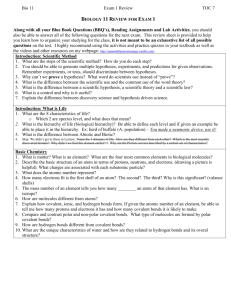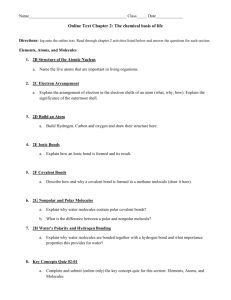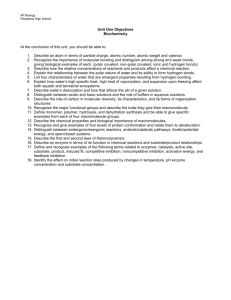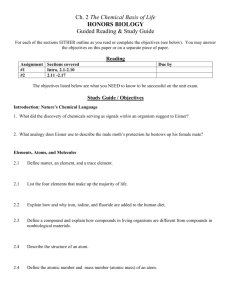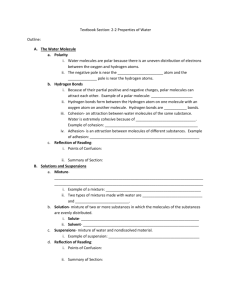AP Intro - BHSGallagher
advertisement
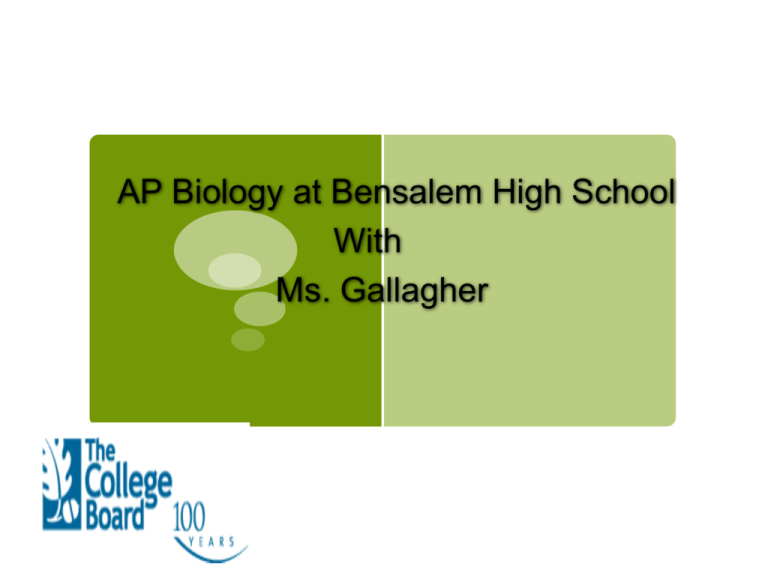
AP Biology at Bensalem High School With Ms. Gallagher A Little about Advanced Placement Courses are designed by “The College Board” To emulate freshman college courses AP Test covers the entire year of work AP BIOLOGY is an 8 credit course. That is two semesters of college-level work Most colleges and universities award students 8 credits if they achieve a 4 or 5. Some colleges accept a 3 for nonscience majors The Exam May 14, 2012 100 Multiple Choice Questions 4 Free Response Questions 3 hour exam Cost: Approx. $85.00 AP BIO AT BHS Laboratory-intense, Inquiry-based We will perform 24 freshman college laboratories Text: Campbell’s Biology, 7th/9th ed. We will complete the entire book, 55 chapters. Entire text is available online at “ The Campbell Place” Resources: Students have a book of notes, a study guide, a textbook, and laboratory manual Additional resources: Campbell’s Biology on-line has animations, self quizzes, and lecture outlines. College Board: Published exams for one year and many years of free response questions. Grading Homework/Classwork – 15% Laboratory Work and Lab Quizzes – 30% Tests and Essays – 55% The AP TEST will count as your final. If you are not taking the test, you will need to take a first and second semester final exam EXTRA CREDIT: Students who participate in PJAS will receive extra credit in the third marking period. WORK LOAD Students are expected to spend at least one hour every night on AP BIO. And more time to prepare for the exam in May. Contacting me: kgallaghe@bensalemsd.org Or 215-750-2800 ex: 3054 Wikispaces: http://bhsgallagher.wikispaces.com Field Trip Suggestions? We’ve done the Zoo for the last several years. Chemical Bonding Covalent Double covalent Nonpolar covalent Polar covalent Ionic Hydrogen van der Waals forces Covalent Bonding Sharing pair of valence electrons Number of electrons required to complete an atom’s valence shell determines how many bonds will form Ex: Hydrogen & oxygen bonding in water; methane Polar/nonpolar covalent bonds Electronegativityattraction for electrons Nonpolar covalent •electrons shared equally •Ex: diatomic H2 and O2 Polar covalent •one atom more electronegative than the other (charged) •Ex: water Ionic bonding High electronegativity difference strips valence electrons away from another atom Electron transfer creates ions (charged atoms) Cation (positive ion); anion (negative ion) Ex: Salts (sodium chloride) Ionic bonds Hydrogen bonds Hydrogen atom covalently bonded to one electronegative atom is also attracted to another electronegative atom (oxygen or nitrogen) Chemical Bonding: Importants points are ??? Ionic Bonds Covalant Bonds Polar Nonpolar Hydrogen van der Waals interactions Weak interactions between molecules or parts of molecules that are brought about by localized charge fluctuations Due to the fact that electrons are constantly in motion and at any given instant, everchanging “hot spots” of negative or positive charge may develop Water Polar: opposite ends, opposite charges Cohesion: H+ bonds holding molecules together Adhesion:H+ bonds holding molecules to another substance Surface tension: measurement of the difficulty to break or stretch the surface of a liquid Special Characteristics of Water •Specific heat: Amount of heat absorbed or lost to change temperature by 1oC •Heat of vaporization: Quantity of heat required to convert 1g from liquid to gas states •Density:Solid state less dense than liquid Density Less dense as solid than liquid Due to hydrogen bonding Crystalline lattice keeps molecules at a distance Acid/Base & pH Dissociation of water into a hydrogen ion and a hydroxide ion Acid: increases the hydrogen concentration of a solution Base: reduces the hydrogen ion concentration of a solution pH: “power of hydrogen” pH Determination: Water : Mostly HOH molecules Very few H+ ions and OH- ion More H+ = Low pH = Acidic More OH- = High pH= Basic pH scale is exponential ( Like seismic waves ) pH + pOH = 14 pH = - log [H+], pOH = - log [OH] pH = exponent in the [H+] Complete the Chart [H+] 10-7 [OH-] pH 10-7 4 10-8 11 Acidic/Basic/Neu tral ? Review Questions 1. How does water stabilize global temperature ? 2. How does sweating help maintain your temperature? 3. Temperature is a measure of ? ______________ 4. How much more acidic is a solution with a pH of 2 versus one with a pH of 4 ? _______________ 5. What is a buffer? Why are they important? 6. How would you make a 0.1 M solution of glucose? 7. Sketch a water molecules showing its shape and the electron shells with the covalently shared electrons. Indicate the areas with slight negative and positive charges that enable a water molecule to form hydrogen bonds.
